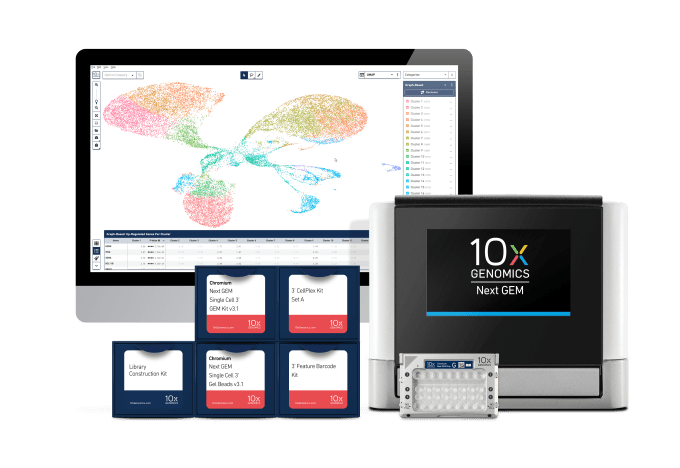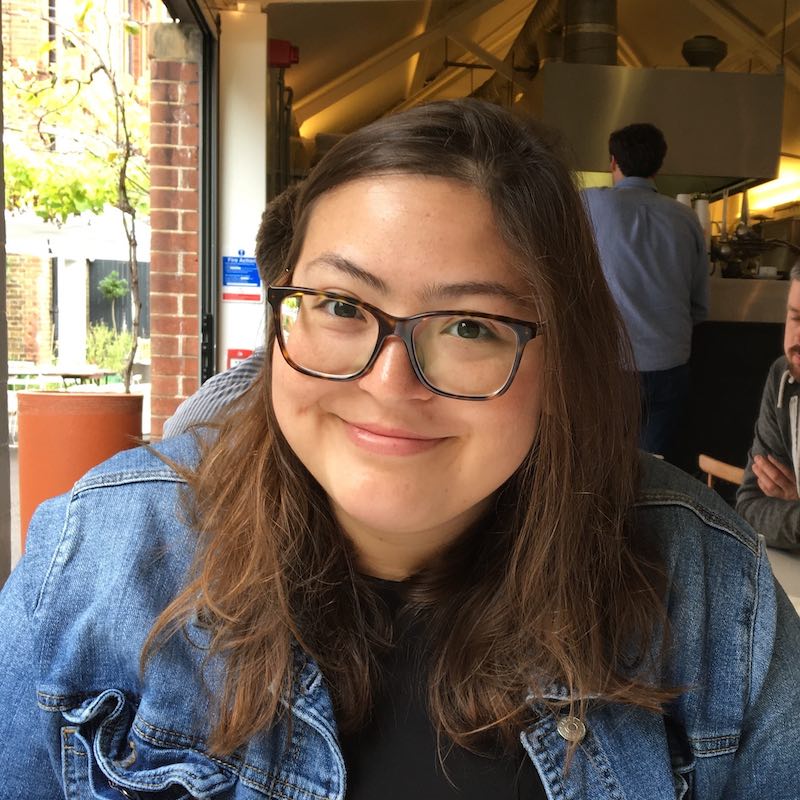Answering Your Questions About Sample Multiplexing for Single Cell Gene Expression
Discover how you can get the most out of your Chromium Single Cell Gene Expression experiments with CellPlex, our new end-to-end solution for sample multiplexing, as 10x-perts answer key questions about scaling your single cell studies and maximizing your insights for every sample. Then, watch our webinar on the technology, available on-demand now.

The past several years of biological study have been driven by single cell gene expression capabilities, but with so many exciting discoveries pushing us forward, what’s next? How can we continue to build on a decade-defining technology? What we need is more. More throughput, more flexibility, more cells.
CellPlex is designed to give you more discovery power, unlocking single cell insights for every one of your samples. That can mean enabling experiments with large patient cohorts, but it can also mean multiplexing samples into a single channel to reduce per-sample costs or to maximize insights from a single experiment. Now, with sample multiplexing capabilities, 3’ CellPlex for Single Cell Gene Expression gives you the power to scale your single cell studies to match your research needs. Whether you’re planning a large-scale study or trying to do as much as possible within your budget, it’s essential that you get the most out of every sequencing run, especially as research questions grow increasingly complex. The flexible design and increased throughput enabled by sample multiplexing allows you to better personalize your experimental parameters and address your specific challenges.
In a recent webinar, 10x-ers Jason Koth, Product Manager, and Elliott Meer, PhD, Staff Scientist, introduced 3’ CellPlex technology, delving into the science behind it and how it can advance your studies, at any scale. Walking us through the workflow, they discussed the advantages of sample multiplexing—for example, decreasing cost per sample or profiling cells across diverse conditions, including time-course studies and dose-response titrations, in a single run. They also talked about how CellPlex may play a role in the future of biology, not only driving innovation but making single cell studies more accessible to the wider scientific community.
You can watch the full on-demand webinar now, or keep reading for a preview of some of the highlights from the Q&A following the presentation.
How it works
What is used to label cells for sample multiplexing?
The 3’ CellPlex kit contains 12 different oligo-conjugated lipid tags or Cell Multiplexing Oligos (CMOs) that can incorporate into cell and nuclear membranes to label cells from individual samples.
Are different Gel Beads and chips required with CellPlex?
The 3’ CellPlex Kit was designed to be compatible with the existing Gel Beads and chips for the Chromium Single Cell 3’ v3.1 Dual Index assay. Therefore, if you have already purchased Single Cell 3’ v3.1 Gel Beads and Chromium Next GEM Chip G, you can use those. Additional items that will need to be purchased include two new kits (the 3’ CellPlex Kit and Dual Index Kit NN Set A) and the 3’ Feature Barcode Kit, which has an updated part number (1000262) due to the inclusion of a new primer required for multiplexing library preparation.
Experimental design
Which 10x Genomics assays are compatible with sample multiplexing?
Sample multiplexing is currently only supported for use with the Single Cell 3’ v3.1 Dual Index assay. We currently do not have any CellPlex products for the Single Cell ATAC or Single Cell Multiome ATAC + Gene Expression assays, but we are working on developing a 5’ CellPlex Kit that will be compatible with the Single Cell 5’ assay. The Cell Multiplexing Oligos (CMOs) in the 3’ CellPlex Kit contain Capture Sequence 2, allowing them to be captured by Single Cell 3’ v3.1 Gel Beads. However, the Gel Beads in other products (Single Cell Immune Profiling, Single Cell ATAC, and Single Cell Multiome ATAC + Gene Expression) do not contain Capture Sequence 2 and therefore will not capture the CMOs from the 3’ CellPlex Kit.
How many samples can I pool together?
Up to 12 cell/nuclei samples can be pooled together and loaded onto one channel of a Chromium chip. We recommend pooling samples at equal ratios to ensure optimal cell multiplet detection. However, it is technically possible to use unequal pooling ratios, and we support pooling ratios of 5% to 95%. Ratios below 5% are not supported. If one CMO tag is represented by fewer than 5% of the total cells, there may not be sufficient data for that particular tag for optimal performance of the Cell Ranger tag–calling algorithms
How many cells can I recover?
We support a targeted cell recovery of 500 to 30,000 cells with CellPlex. It is important to note, however, that the number of “cells” called by Cell Ranger will be less than the targeted cell recovery, given that some cells will be partitioned together into the same GEM. The User Guide will contain details on the number of cells we expect to be called by Cell Ranger at each of the different cell loads.
Can I use CellPlex with limited cell numbers?
We do not recommend using CellPlex if you have fewer than 100,000 cells or nuclei per sample as the protocol for labeling includes multiple washes, and approximately 50% of cells are expected to be lost during this protocol. If fewer than 100,000 cells are used as input, there may not be sufficient cells remaining after CMO-labeling for accurate cell counting, pooling, and loading onto the chip.
Sample preparation for CellPlex
What sample types are compatible with CellPlex?
CellPlex is compatible with both cells and nuclei, and we have tested the 3’ CellPlex Kit with a range of different cell types and cell sizes, observing excellent assay performance across all samples tested. We validated CellPlex on human, mouse, rat and monkey samples. In terms of cells, we’ve tested peripheral blood mononuclear cells (PBMCs) from human, mouse, rat and monkey; human and mouse cell lines; human dissociated tumor cells; and mouse dissociated embryonic brain tissue. We’ve tested nuclei isolated from human PBMCs, human and mouse cell lines, human dissociated tumor cells, and mouse dissociated embryonic brain tissue.
Is flow cytometry compatible with CellPlex?
Yes, CMO-labeled cells or nuclei are compatible with flow cytometry. Sorting CMO-labeled samples can improve data quality by enriching for viable cells, eliminating debris, and reducing background from unbound CMOs. Cells can be sorted using a live/dead stain, and nuclei can be sorted based on forward and side scatter.
At the final resuspension step in the CMO-labeling protocol, the CMO-labeled cells can be resuspended in a sorting buffer appropriate for your cell type. The CMO-labeled samples can then be sorted one-at-a-time and pooled together after sorting. Alternatively, the CMO-labeled samples can be pooled together prior to sorting, and sorted together as one sample.
Sorting can also be performed to enrich for specific cell types of interest. For example, cells can be labeled with fluorescent antibodies for cell surface markers. We will be providing a Demonstrated Protocol for labeling cells with both antibodies and CMOs.
Data analysis
Which software can be used for data analysis?
We have released a new version of Cell Ranger, version 6.0, which includes pipelines for analyzing CellPlex data. This software demultiplexes data based on the tag assignment, generating separate output files for each of the cell or nuclei samples in your pool. This software also identifies and filters out cell multiplets that contain two or more cells with different tags.
Can I identify and filter out cell multiplets?
Cell multiplets occur when two or more cells are partitioned into the same GEM, but the percentage of GEMs that contain multiplets in a given experiment will depend on the Targeted Cell Recovery. As more cells are loaded onto the chip, it becomes more likely that two cells will be partitioned together into the same GEM. There are ways to improve multiplet detection, as detailed by a new Technical Note that describes best practices for experimental design to optimize cell multiplet detection.
Additionally, our Cell Ranger software analysis pipelines can identify and filter out some cell multiplets, specifically those containing cells labeled with different CMO tags. Cell multiplets containing cells labeled with the same CMO tag, however, cannot be identified as multiplets in Cell Ranger and will not be filtered out.
Want more answers? Watch the on-demand webinar now, or read more about CellPlex here.
